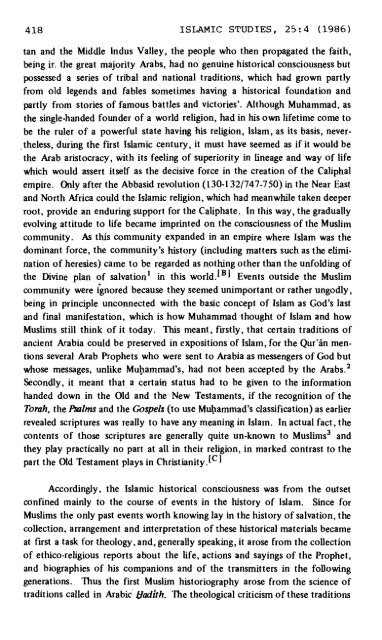ISLAMIC & WESTERN HISTORIOGRAPHY
ISLAMIC & WESTERN HISTORIOGRAPHY
ISLAMIC & WESTERN HISTORIOGRAPHY
You also want an ePaper? Increase the reach of your titles
YUMPU automatically turns print PDFs into web optimized ePapers that Google loves.
4 18 <strong>ISLAMIC</strong> STUDIES, 25:4 (1986)<br />
tan and the Middle lndus Valley, the people who then propagated the faith,<br />
being ir. the great majority Arabs, had no genuine historical consciousness but<br />
possessed a series of tribal and national traditions, which had grown partly<br />
from old legends and fables sometimes having a historical foundation and<br />
partly from stories of famous battles and victories'. Although Muhammad, as<br />
the single-handed founder of a world religion, had in his own lifetime come to<br />
be the ruler of a powerful state having his religion, Islam, as its basis, nevertheless,<br />
during the first Islamic century, it must have seemed as if it would be<br />
the Arab aristocracy, with its feeling of superiority in lineage and way of life<br />
which would assert itself as the decisive force in the creation of the Caliphal<br />
empire. Only after the Abbasid revolution (130-1 321747-750) in the Near East<br />
and North Africa could the Islamic religion, which had meanwhile taken deeper<br />
root, provide an enduring support for the Caliphate. In this way, the gradually<br />
evolving attitude to life became imprinted on the consciousness of the Muslim<br />
community. As this community expanded in an empire where Islam was the<br />
dominant force, the community's history (including matters such as the elimination<br />
of heresies) came to be regarded as nothing other than the unfolding of<br />
the Divine plan of salvation1 in this world.[ B1 Events outside the Muslim<br />
community were i'gnored because they seemed unimportant or rather ungodly,<br />
being in principle unconnected with the basic concept of Islam as God's last<br />
and final manifestation, which is how Muhammad thought of Islam and how<br />
Muslims still think of it today. This meant, firstly, that certain traditions of<br />
ancient Arabia could be preserved in expositions of Islam, for the Qur'in mentions<br />
several Arab Prophets who were sent to Arabia as messengers of God but<br />
whose messages, unlike Muhammad's, had not been accepted by the Arab~.~<br />
Secondly, it meant that a certain status had to be given to the information<br />
handed down in the Old and the New Testaments, if the recognition of the<br />
Tomh, the Balms and the Gospels (to use Muhammad's classification) as earlier<br />
revealed scriptures was really to have any meaning in Islarn. In actual fact, the<br />
contents of those scriptures are generally quite un-known to ~uslims~ and<br />
they play practically no part at all in their religion, in marked contrast to the<br />
part the Old Testament plays in ~hristianit~.[~]<br />
Accordingly, the Islamic historical consciousness was from the outset<br />
confined mainly to the course of events in the history of lslam. Since for<br />
Muslims the only past events worth knowing lay in the history of salvation, the<br />
collection, arrangement and interpretation of these historical materials became<br />
at first a task for theology, and, generally speaking, it arose from the collection<br />
of ethico-religious reports about the life, actions and sayings of the Prophet,<br />
and biographies of his companions and of the transmitters in the following<br />
generations. Thus the first Muslim historiography arose from the science of<br />
traditions called in Arabic &x.fith. The theological criticism of these traditions
















